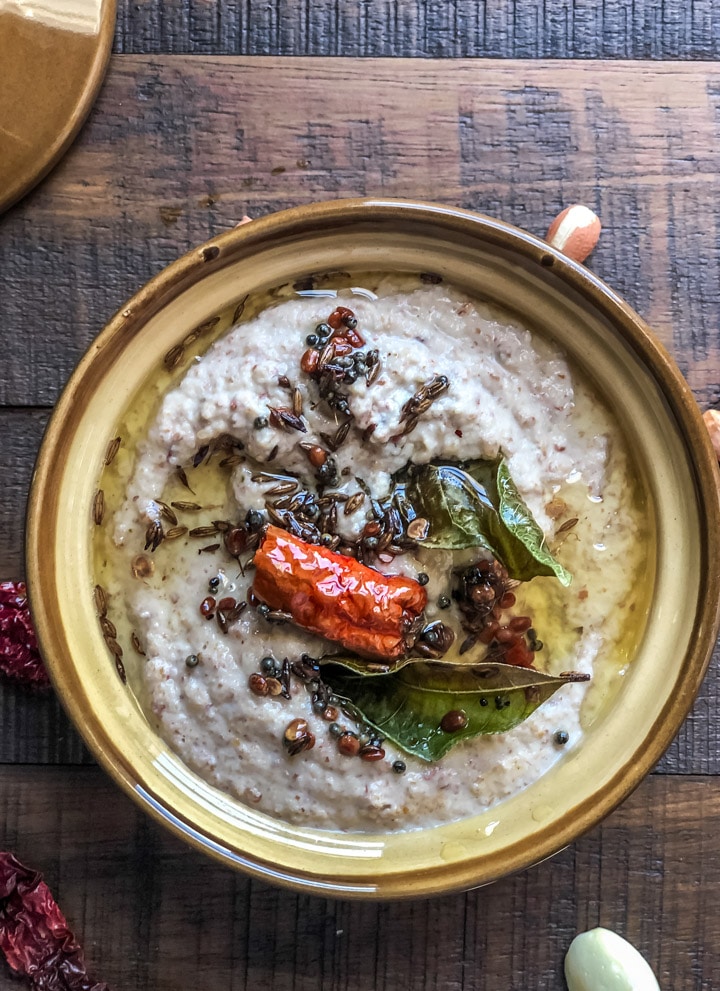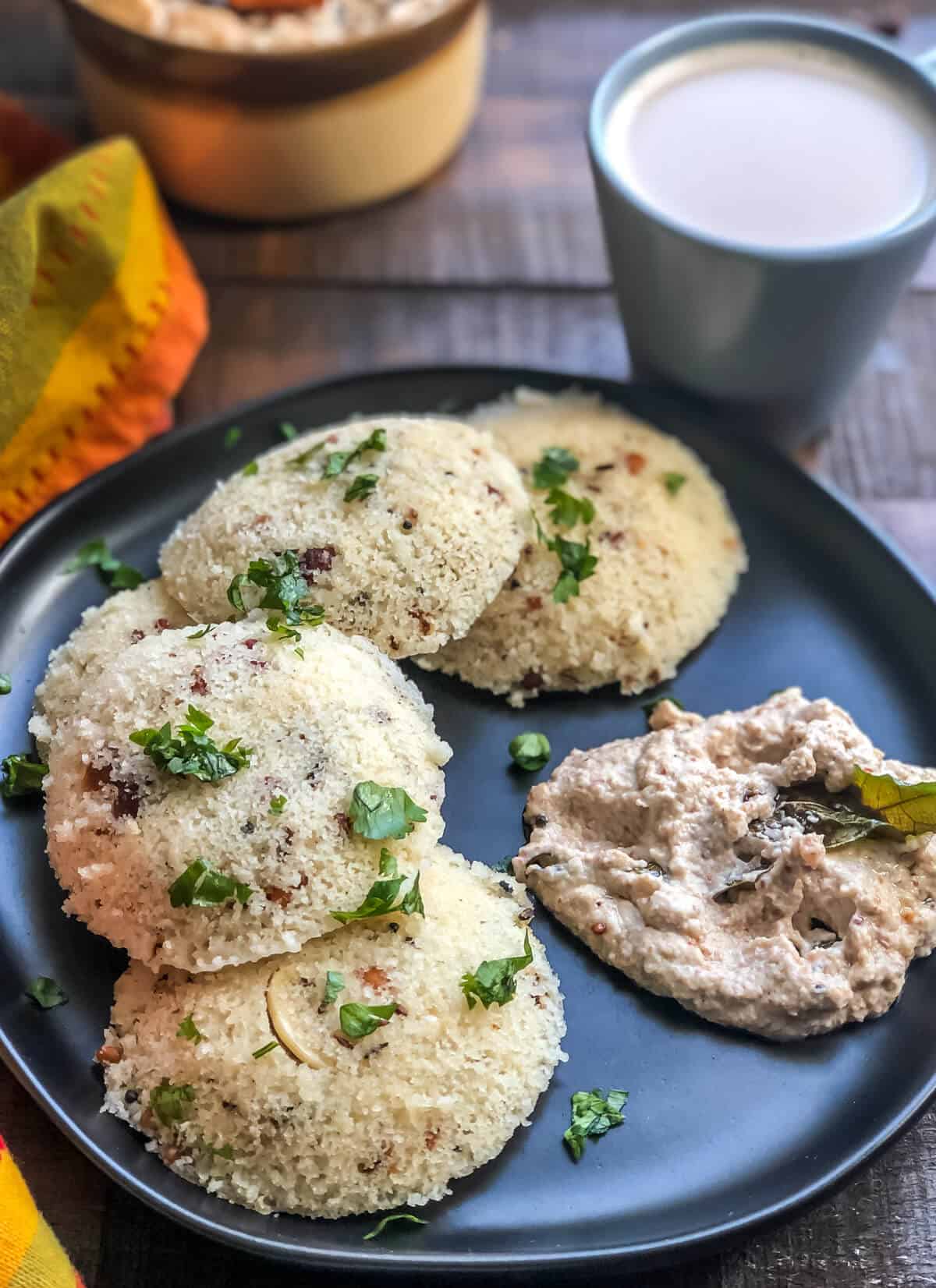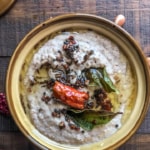Should you love peanuts, this Andhra style peanut chutney is for you. Creamy and finger-licking good, this groundnut chutney is an ideal accompaniment to piping hot idlis, vadas or dosas.

Not too way back, a friend of mine who’s originally from Andhra Pradesh served this peanut chutney (also called palli chutney) with vada. While the vadas were nice and crispy, what bowled me over was the chutney. It was creamy, stuffed with flavor and coconut lovers, don’t hate me for saying this – tasted so a lot better than coconut chutney.
I ended up ignoring the vada and just lapping up the chutney spoonfuls at a time. Her peanut or groundnut chutney was that good! That meant I HAD TO get the recipe to share it with you, my friends :).
The way to make peanut chutney?
What you’ll love about this recipe is that it doesn’t need a ton of ingredients and comes together in about 10 minutes. Since this chutney doesn’t have grated coconut it could last within the refrigerator for about 7 days without going bad or losing flavor.
To make peanut chutney, follow the directions below –

-
Add a tablespoon of peanut oil in a pan kept over medium heat.
-
Add garlic cloves, peanuts, and chopped green chilies. Saute them for about 5 minutes till the peanuts have evenly browned.
-
Grind this peanut mixture together with seedless tamarind [see note], salt and water to a rough paste. Set it aside.
-
Add the remaining 1 tablespoon of oil to the identical pan and set it on medium heat.
-
When the oil heats up, add cumin and mustard seeds and after they begin to crackle, add urad dal, byadgi chilies, asafoetida, and curry leaves.
-
Fry them for about 10 -15 seconds and take the pan off heat.
-
Pour the tempering to ground peanut chutney and blend well.
-
Serve it immediately with idlis/dosas or refrigerate as much as 7 days.
Suggestions
- I prefer using wet seedless tamarind since I can grind them directly but should you are using the dried tamarind, take chunks of it concerning the size of 1 / 4 from the package. Soak it in 1/2 cup hot water for about 10 minutes before use. You may also substitute seedless tamarind with 1/2 teaspoon tamarind paste.
- It is tough to predict how tangy the tamarind juice shall be, so all the time add 1/2 of the tamarind juice first, do a taste test and add the remaining.
- Should you are using juice from tamarind soaked in 1/2 cup of water, you might not need additional water to grind the chutney.
Variations
- Peanuts with skin have a lot flavor and are more nutritious than those without. You can substitute them with ones without skin should you don’t have them in your pantry.
- Dry roasting the peanuts/groundnuts can also be an option should you don’t need to use oil.
- To make peanut chutney with onion, add 1/4 cup chopped onions and saute it together with garlic. Grind it with the remainder of the ingredients.
Fun fact – Difference between peanuts and groundnuts
For those wondering why peanuts and groundnuts are used interchangeably, here’s a fun fact – peanut is a type of groundnut which belongs to the legume family. If you wish to dig deeper, read – the difference between groundnut and peanut.

Should you are searching for more chutney recipes, listed here are a couple of more you can pair your Indian breakfast and snacks –
- Red chili chutney – a spicy and tangy chutney perfect for south Indian snacks.
- Coriander chutney – This green chutney is ideal for street food.
- Coriander-mint chutney – A delicious combination of cilantro and mint makes it perfect for sandwiches, idlis, and even street food.
- Coconut chutney – Most South Indian breakfast and snacks can’t do without coconut chutney – a coconut-based dip that all of us like to dunk our idli and dosas in.
- Tamarind date chutney – Here is an excellent easy, quick yet delicious recipe to make this mouthwatering at home using your Easy Pot. Stovetop instructions are included too!
- Vada pav chutney – This zesty garlic chutney is what makes vada pav so tantalizingly good. It has a protracted shelf life and also you’ll find that it’s an excellent option to amp up your meals.

Click on the celebrities to rate!
Andhra Style Peanut Chutney Recipe
Should you love peanuts, this Andhra style peanut chutney is for you. Creamy and finger-licking good, this groundnut chutney is an ideal accompaniment to piping hot idlis, vadas or dosas.
To be ground
- 2 tablespoons peanut oil divided
- 3-4 garlic cloves
- 1 cup peanuts with skin
- 2 green chilies
- ½ teaspoon seedless tamarind
- ½ teaspoon salt
- ¾ cup water
Prevent your screen from going dark
-
Add a tablespoon of peanut oil in a pan kept over medium heat.
-
Add garlic cloves, peanuts, and chopped green chilies. Saute them for about 5 minutes till the peanuts have evenly browned.
-
Grind this peanut mixture together with seedless tamarind [see note], salt and water to a rough paste. Set it aside.
-
Add the remaining 1 tablespoon of oil to the identical pan and set it on medium heat.
-
When the oil heats up, add cumin and mustard seeds and after they begin to crackle, add urad dal, byadgi chilies, asafoetida, and curry leaves.
-
Fry them for about 10 -15 seconds and take the pan off heat.
-
Pour the tempering to the bottom peanut paste and blend well.
-
Serve it immediately with idlis/dosas or refrigerate as much as 7 days.
Suggestions
- I prefer using wet seedless tamarind since I can grind them directly but should you are using the dried tamarind, take chunks of it concerning the size of 1 / 4 from the package. Soak it in 1/2 cup hot water for about 10 minutes before use.
- You may also substitute seedless tamarind with 1/2 teaspoon tamarind paste.
- It is tough to predict how tangy the tamarind juice shall be, so all the time add 1/2 of the tamarind juice first, do a taste test and add the remaining.
- Should you are using juice from tamarind soaked in 1/2 cup of water, you might not need additional water to grind the chutney.
Variations
- Peanuts with skin have a lot flavor and are more nutritious than those without. You can substitute them with ones without skin should you do not have them in your pantry.
- Dry roasting the peanuts/groundnuts can also be an option should you don’t desire to make use of oil.
- To make peanut chutney with onion, add 1/4 cup chopped onions and saute it together with garlic. Grind it with the remainder of the ingredients.
Disclaimer: Approximate dietary information is provided as a courtesy and may vary depending on the precise ingredients/brands used. If you might have health issues, please work with a registered dietician or nutritionist.
Calories: 192kcalCarbohydrates: 6gProtein: 7gFat: 17gSaturated Fat: 3gSodium: 251mgPotassium: 187mgFiber: 3gSugar: 1gVitamin A: 35IUVitamin C: 9mgCalcium: 29mgIron: 1mg



